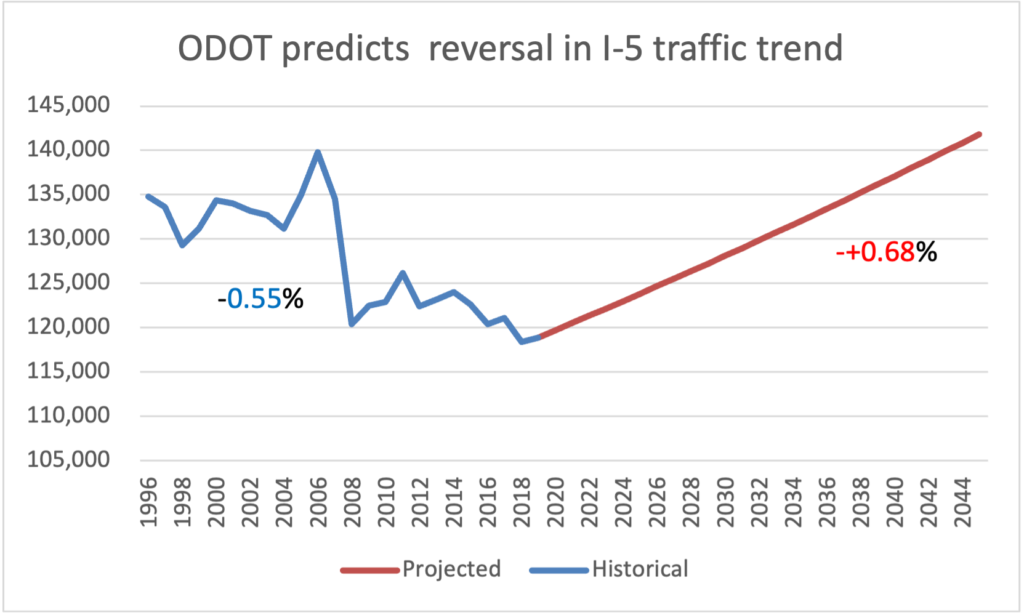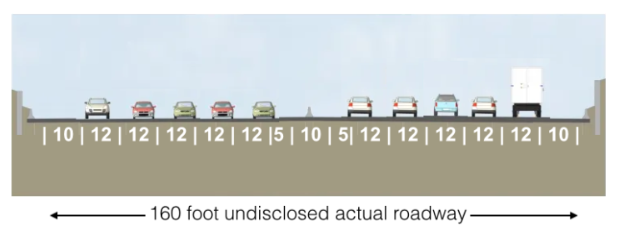What City Observatory did this week
The case against the I-5 Rose Quarter freeway widening. This week marked the end of public comment on the Supplemental Environmental Assessment for the Oregon Department of Transportation’s proposed $1.45 billion I-5 Rose Quarter freeway widening projects. At a billion dollars a mile, its one of the world’s most expensive, and anachronistic freeway projects. It proposes to double down on the damage done to Portland’s historically Black Albina neighborhood, flooding the area with even more traffic, and making local streets less safe and desirable for residents, and people biking and walking. If ever there were a project that needed a full Environmental Impact Statement, this is one, but instead, ODOT is asserting that the project has “no significant environmental impact.” Here we summarize more than 50 City Observatory commentaries published over the past five years explaining the project’s true economic, environmental and social impacts.
Traffic is declining at the Rose Quarter: ODOT growth projections are fiction. ODOT’s own traffic data shows that daily traffic (ADT) has been declining for 25 years, by -0.55 percent per year. The ODOT modeling inexplicably predicts that traffic will suddenly start growing through 2045, growing by 0.68 percent per year.
ODOT’s modeling falsely claims that traffic will be the same regardless of whether the I-5 freeway is expanded, contrary to the established science of induced travel. These ADT statistics aren’t contained in the project’s traffic reports, but can be calculated from data contained in its safety analysis. ODOT has violated its own standards for documenting traffic projections, and violated national standards for maintaining integrity of traffic projections.
The truth about ODOT’s proposed $1.45 billion freeway widening. It’s really an 8 or 10-lane highway expansion, not just the addition of so-called “auxiliary” lanes.” The project is engineered to be vastly wider than needed so it can be re-striped after it is constructed. ODOT has failed to reveal these facts in its Environmental Assessment.
- To avoid intruding on the Eastbank Esplanade, ODOT has dropped its plans to widen the viaduct overhanging the pathway, but will squeeze in another lane of traffic by re-striping the existing 83′ wide viaduct.
- At the project’s key pinch point, the Weidler overpass, ODOT is engineering a crazy-wide 160 foot wide roadway ostensibly for just for six travel lanes. But this roadway is more than enough to fit 8 or even 10 lanes of traffic, just by striping it as they are now planning to stripe the viaduct section of the project.
- ODOT’s environmental analysis has violated NEPA by failing to consider this “reasonably foreseeable” eventuality that ODOT will re-stripe the project to 8 or more lanes, which would produce even more traffic, air pollution and greenhouse gases, impacts that are required to be disclosed.
- ODOT has also violated NEPA by failing to consider a narrower right of way: 96 feet would be sufficient to accommodate its added “auxiliary lanes” and would have fewer environmental impacts and lower costs.
- ODOT’s safety analysis for its narrowing of the viaduct section shows that narrower lanes and shoulders make almost no difference to the crash rate, and further show that the project’s claims that it would reduce crashes on I-5 by 50 percent are exaggerated by a factor of at least seven. The analysis also shows that the project has a safety benefit-cost ratio of about 1 to 200, meaning it costs ODOT $2 for 1 cent of traffic crash reductions, about 2,000 times less cost-effective that typical safety projects.
- The safety analysis also confirms that ODOT made now allowance for the effects of induced demand: It makes it clear that the project assumed that traffic levels would be exactly the same in 2045 regardless of whether the freeway was expanded or not.
The IBR project: Too much money for too many interchanges. The real expense of the $5 billion I-5 bridge replacement project isn’t actually building a new bridge over the Columbia River: It’s widening miles of freeway and rebuilding every intersection north and south of the river. A decade ago, an independent panel of experts convened by OR and WA governor’s strongly recommended to ODOR and WSDOT that they eliminate one or more intersections. The panel concluded that 70 percent of the cost of the project was rebuilding 7 interchanges in five miles.The experts told ODOT and WSDOT that project interchange spacing violates both federal and state design standards. The expert panel concluded that eliminating interchanges would reduce project cost, improve safety, and improve traffic flow.
Failing to look at removing or simplifying intersections after getting this expert advice is arbitrary and capricious; ODOT and WSDOT are violating the National Environmental Policy Act’s requirement that they take a hard look at reasonable alternatives.
Must Read
Jerusalem Demsas thinks that promoting homeownership as a national investment policy was a mistake. Writing at The Atlantic, Jerusalem Demsas as a provocative essay that takes on one of the most cherished myths in America, the importance of homeownership as a broadly shared wealth-building strategy. She starts with an observation we’ve long stressed at City Observatory: housing policy is based on a fundamental contradiction: we want housing to be affordable, and we want it to be a great investment. You simply can’t have it both ways. And in practice, a whole raft of policies, from the federal tax code to local zoning strongly favor making housing unaffordable (especially for the young, poor, and renters) at the expense of making it a great investment for older, wealthier long-time home-owners.
While homeownership is touted as a universal wealth-building strategy, whether you make a return on investment depends heavily on when, where and how you buy. Homeownership has tended to increase rather than reduce wealth inequality because lower income households tend to buy at the wrong time, in the wrong place, and end up paying higher prices and interest rates, which cut into their financial returns. And, over time, most of the accumulated wealth from housing investment has ended up in the hands of older Americans who had the tax-favored good luck to buy when (and where) they did.
The policy lesson from this is clear: we ought to stop selling (and subsidizing) homeownership, and put our policy emphasis plainly on promoting affordability. Demsas writes:
I should be explicit here: Policy makers should completely abandon trying to preserve or improve property values and instead make their focus a housing market abundant with cheap and diverse housing types able to satisfy the needs of people at every income level and stage of life. As such, people would move between homes as their circumstances necessitate. Housing would stop being scarce and thus its attractiveness as an investment would diminish greatly, for both homeowners and larger entities. The government should encourage and aid low-wealth households to save through diversified index funds as it eliminates the tax benefits that pull people into homeownership regardless of the consequences.
Perhaps growing awareness of the long-brewing housing crisis in the US will lead more people to give some thought to this idea.
New Knowledge
Insights into 15 minute living. Economist Ed Glaeser and a team of researchers have used mobile phone and amenity location data to look at the relationship between accessibility and “15 minute walking”.
The authors gather data on 11 billion (!) 2019 trips to “points of interest” (a grab bag term for destinations ranging from schools and parks to grocery stores and restaurants). They then examine differences in trip-making patterns between locations with abundant local destinations and those with fewer destinations nearby. The data provide a useful test-bed for seeing how living in a “15-minute neighborhood”–a place with lots of common destinations within a 15 minute walk–influences travel behavior.
In a statistical sense, 15-minute access can explain eighty percent of the variation in 15-minute usage across metropolitan areas and 74 percent of the variation in usage within metropolitan areas. A one percentile increase in access is associated with a .8 percentage point increase in the share of trips that are within 15 minutes walking distance. This coefficient is not particularly sensitive to other controls, including population density, income and share of the population in the block group that owns a car. This correlation does not imply that encouraging more mixed-use development within residential areas will reduce average trip times, but it is certainly compatible with that hypothesis
Timur Abbiasov, Cate Heine, Edward L. Glaeser, Carlo Ratti, Sadegh Sabouri, Arianna Salazar, and Miranda Paolo Santi, The 15-minute city quantified using mobility data, NBER Working Paper 30752 http://www.nber.org/papers/w30752 NATIONAL BUREAU OF ECONOMIC RESEARCH
In the News
Commentaries by City Observatory’s Daniel Kay Hertz and Joe Cortright were featured prominently in Jerusalem Demsas’ Atlantic article on the problems with homeownership policy. Demsaas quoted Hertz’s observation that housing is a sustained intergenerational transfer of wealth from old to young, and Cortright’s analysis of why, in practice, homeownership turns out to be a wealth destroying strategy for the poor and people of color.







